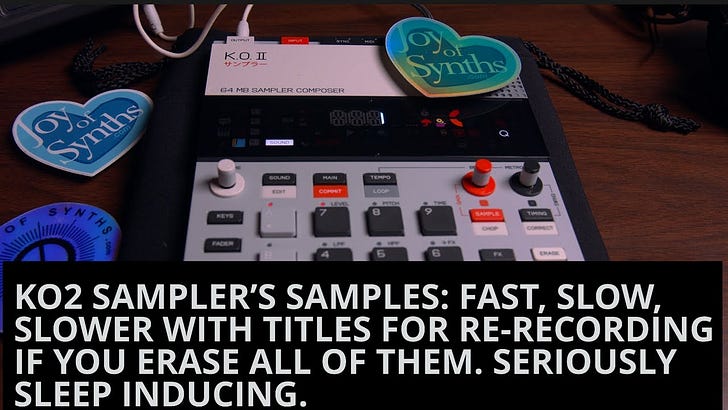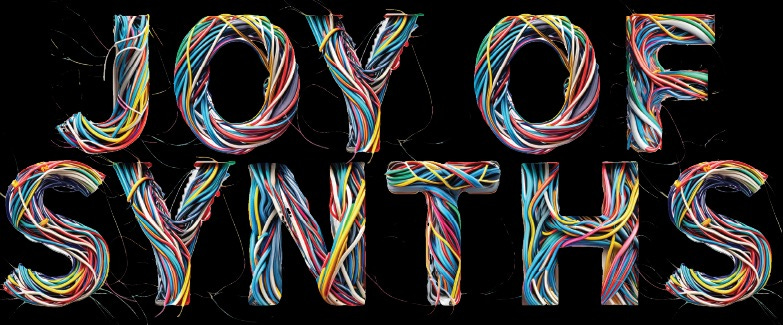Joy of Synths #10: KO 2 Sampler + Kobol Expander
A non-musician’s guide to creating sounds for podcasts, videos, and sampling for music using analog synthesizers.
K.O. 2 VIDEO
I’m really impressed by Teenage Engineering’s K.O. 2. This has been my daily go-to instrument for the Holidays. It’s an all-in-one sampler, including microphone and speaker.
I haven’t used it to build a song. While I read the manual start to finish, about 1/99th of it stuck to memory. The main thing to know from the manual is that you can erase all the factory samples. Most would expect some sort of reset, but nope, everything will go.
To remedy this, or pre-empt this risk, I recorded every sample, long holding on the key so the title flashes by. That video is here:
However, this Google drive link has all the KO2 EP-133 samples already chopped up and zipped, thanks to a user on Reddit. Download at your own risk, though no viruses popped up on a Mac.
Granted, you could work with these samples in any non-linear editor for audio or video. What I enjoy about playing the KO2 is pressing buttons and turning dials for FX without resorting to a MIDI controller and computer.
Most of my time has been spent on the FX>Delay and turning up the dials for feedback, which has been coded to not blow out the KO2 speakers.
KO2 as MIDI Controller
After playing with the K.O. in a minimal way, next is to play through manual with the KO2. So yes, read the forgotten manual.
I’ve been curious to see how the KO2 works as a MIDI controller of an analog synth with a MIDI IN port.
From what I recall, the MIDI OUT of the KO2 is a mini jack that transmits messages for Note and Note On/Off, which translates to V/O (volts per octave, or pitch) and Gate signal. Which is to say, super basic. How it manages moving up and down octaves is to be determined.
Update: It’s been determined. You need a Make Noise 0-Coast MIDI Cable - Type A 3.5mm TRS to 5-pin MIDI. Sweetwater sells that for $5. Then a full-size 5-pin MIDI cable to connect to a synth with a full-size 5-pin MIDI IN port.
The KO2 is a fun MIDI controller of analog synths that have a MIDI IN port or a MIDI to CV module. KO2’s MIDI OUT is turned off, so you have turn MIDI ON by assigning a Channel, or CH.
Press Shift and Sound together. Then press a number key like 7. Then use the + and - to get to MIDI OFF. To turn MIDI on, turn one dial to CH1 for Channel 1, the default for most all analog synths. The second dial will select the note, for example, C5 which is the C note.
Repeat the above MIDI assignments for the remaining numbered keys on the KO2. I set my top row to be C2, C4, C6, so the sound would rise 2 octaves, or low to high.
I’m floored by how much fun it is to play an analog synth with the KO2. This is what MIDI promised way back when- new ways of interfacing with instruments.
MULTIPLE MIDI FUN
Assigning MIDI to the KO2’s buttons doesn’t take away their ability to play samples. You can play the KO2 as a sampler while each button press triggers a note on/off on the analog synth. This is fun if you apply the KO2’s FX Delay to percussive samples and record the KO2 as mono with a 3.5mm to TS interconnect 1/4” jack into a two track H4N that accepts instrument cables. The second jack would be for the analog synth.
If you have two analog synths with MIDI IN and MIDI THRU, or just MIDI IN and a MIDI splitter cable,, you can control the 2 analog synths separately by assigning a row of buttons to CH1 and another to CH2. You would change the DIP Switch on the back of one Synth to be 2. So now you'd have a blend of two synths.
The MIDI messages for CH2 will be ignored by the synth set as CH1.
Now you’d want a recorder that allows for all the instruments to be recorded as their own independent channel. The H4N caps out at 2 channels. The H6N has 4 instrument inputs, in addition to a stereo 3.5mm input that overrides the detachable microphones.
KOBOL EXPANDER SEMI MODULAR SYNTH
Damn this sounds different from every synth I own. This clone/reissue is said to be a 1970’s French take on the Model D. What’s crazy about the Kobol Expander is how much can be controlled by voltage and modulated. It has way more CV patch points than the B. Model D, which has 3 oscillators and can be patched in interesting ways just using one oscillator.
I can’t really hear a benefit to Kobol waveforms being modulated. It’s not the same sound as wave shaping, which involves folding a sine wave or other wave shape upon itself to produce new harmonics.
The MIDI implementation is basic pitch and note on/off. I don’t hear velocity, or loud quiet depending on how fast/hard I press the keys of a MIDI keyboard controller. (The KO2 doesn’t transmit velocity messages.) In contrast, the B. Model D responds to Velocity and After Touch.
The Kobol is truly a patchable synthesizer intended to be driven by voltage rather than MIDI keyboard. It has clearly marked inputs for V/O (volts per octave, or pitch) and GATE for those with analog sequencers or keyboards with CV outputs.
It has 2 Low Frequency Oscillators and two Envelope Generators with Attack Decay Sustain dials. The box comes with 2 patch cables. That’s not enough. You’ll want a lot of patch cables and possibly a few splitters (basic headphone splitters work) or Tip Top Audio Stackcables to multiply the signal for the LFOs or Envelope Generators.
SIGNAL SPLITTERS
Some may argue that splitting the signal diminishes its output. That is the case if using an unpowered splitter to multiply V/O or Pitch signals. Those fine voltage numbers run the risk of dropping. However, a basic LFO wave shape or Envelope Generator shape shouldn’t be overly affected. In other words, try the unpowered external splitters before investing in a powered signal multiplier Eurorack module. These are called “buffered” mults, which is short for multipliers.
More Voltage, More Control
I invested in Control Voltage sources in 2022-2023 from Buchla Tip Top Audio, specifically the Quad Function Generator, Sequencer, and Sources of Random. I’ve yet to connect them to the Kobol Expander so we’ll see how it all connects together.
Just using the LFO has proven amazing. This is definitely a “record everything every time” synth, which is the best kind of synth because that means it is generating unique sounds you don’t want to miss!
End Note 12/31/2023
Cheers to New Years 2024!
I posted a second YouTube video about recording the KO 2, so check https://youtube.com/@joyofsynths.
The video about Korg SQ-1 sequencer didn’t work out as a quick edit. It’s probably faster to script and reshoot than try to patch together the footage I recorded a few months ago. The SQ-1 is a great performative/improvisation sequencer, but its controls are very non-intuitive initially. I want to ensure those details are there before releasing an SQ-1 video.
My 2024 Goal is to alternate between recording sounds and recording learning videos. While I want to release something weekly, that means I need to dedicate space for the synths and the camera. Hello Kitchen Table!
Enjoy the start of 2024! Joy #11 will arrive on 01/15/2024. Cheers! - Anthony Torres
This issue is sponsored by CoWolves. Buy vinyl at https://discogs.com/seller/cowolves.
All Content Copyright 2024 Anthony Torres, All Rights Reserved.




